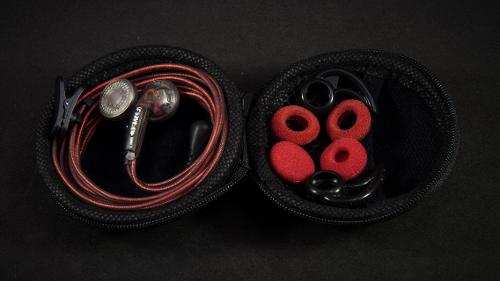Campfire Audio Lyra
"Hard-shelled beauty!"Firstly, I’d like to thank dmarco for organising this review. It’s always a great opportunity to be a part of these.
The second on the list coming from Campfire Audio is another beaut of an IEM, the Lyra. This one is completely different to the Orion. Of the three new IEMs this one is probably the most unique. Instead of a CNC machined shell it's made from heat treated ceramic and a single dynamic driver, but like it's other 2 brothers it comes with pretty much all the same accessories including that amazingly bling looking cable. Let's see how it stacks up.
A little about the Campfire Audio Lyra
More info at the CA website: http://campfireaudio.com/lyra/| Frequency response | 8 - 28 000 Hz |
| Impedance | 17 Ohm |
| Sensitivity | 110 dB |
| Plug | Gold Plated 3.5mm (1/8”) 90° Angled Beryllium and Copper Custom Alloy MMXC |
| Cable Length | 1.48m (SPC) |
| Speaker diameter | Single 8.5mm Beryllium PVD Dynamic |
Build
Housing
If the Orion had a world class build quality, then the Lyra is interstellar. The ceramic doesn't just look stunning with it's glossy, smooth finish but the material is super strong and has a LOT of heft to it. I bet this is one of the IEMs that would still be around, working 50 years down the line.The choice of ceramic has its advantages, yes, both acoustically and physically, but at the same time has its down sides as well. I found the extra heft a bit of a burden on not just getting a good seal, but also being limited to the types of ear tip that would work with them. The extra weight tends to pull the earpieces out of your ear when using my normally preferred tips. This led me to the conclusion of only 2 choices: 1) using tips that are one size larger effectively making long listening session a little uncomfortable, and 2) only using foam tips. For the purposes of comfort, I defaulted to only using the provided foam tips, which were not bad, but had a negative impact on bass response and soundstage.
Cable
The cable is the same as the Orion, so I will paraphrase, or better yet just copy/paste from that review:This cable is absolutely divine! Can someone say “Bling, bling!”? The first thing I saw where I unboxed them was the cable and it just melted my heart. I believe that it is tinsel covered SPC wire inside. The MMXC connectors are beryllium and copper custom alloy are housed in a clear acrylic moulded strain relief which fuses with the clear ear guides, which have memory wire and can be shaped to suit your ear shape. The cable is insulated is sparkly silver material which feels tough, yet it’s malleable and surprisingly has a minimal amount of memory. The wire is very slippery which means that it doesn’t snag on clothing and it is very light, so light actually that you can’t even feel it’s presence.
The only dislike I have with it is the way the MMXC connectors rotate freely in the socket. It would be so much better if there was an interference fit of some sort to minimise this.
Packaging
The Lyra comes in the same beautifully and cosmically designed cardboard box with a different sticker on it to represent the Lyra. It's simple no-nonsense and very effective.Accessories
The Lyra comes with almost all the same accessories as before; this time instead of a canvas hard case, it comes with a full leather upholstered case with leather webbing and the same sheep wool inner lining. For the record, I absolutely love this carry case.Campfire Audio include a very nice selection of ear tips that mostly consist of foam tips.
In the box you get:
- 3 pairs of rather standard silicone tips (S/M/L)
- 3 pairs of generic hard foam tips (S/M/L)
- 3 pairs of COMPLY TX-400 foam tips (S/M/L)
- A cleaning brush and ear wax prod.
- A little booklet with all the juice details about the Lyra.
- A little CA "Fanboy" shirt pin. (That's funny, nice touch!)
Sound
All my listening and evaluation consists of various genres of music including but not limited to: trance, house, funk, acoustic, rock, orchestral and electronic.Gear used: Audio-gd NFB-15 amp/DAC, FiiO X1, FiiO E17 (PC as transport). Ear tips used are Fidue dual-flange wide bore for deep semi-deep insertion.
I'm not sure that I'm the target audience for the Lyra. It didn't gel well with my preferences when I first tried it and it still doesn't gel well with me today. It is a slightly V shaped sounding IEM with a pretty big emphasis on the mid and upper bass frequencies. I also found the Lyra to by quite picky with recordings, masters and genres. It sounds exceptional with very well mastered and non-compressed tracks, but when it came down to normal, everyday listening, the Lyra sounded grainy, thin and lifeless. It's shone best with electronic tracks with cleanly separated sound elements and nothing too complex. Soundstage performance can be "OK", with at times above average, but once the bass starts to overwhelm, everything is muddled together.
Treble
The treble is my favourite aspect of the Lyra in the sound department. From close listening I can find 2 or 3 peaks, one at 8kHz, one at 9-10kHz, and one at 12kHz. This effectively means that micro details will be very spot on and very much part of the experience all the time, it's also makes me think that this is a part of why they are so picky with music. Treble has decent attack and bite, with moderate decay.Mids
Mids are a bit of a bummer. They just feel much too lifeless. They're thin and grainy on the top end and might be a little sibilant to some people. Sibilance was just under my threshold and felt like it was border lining at times, but I never got the feeling where I had to turn it down. Female vocals are flat and two dimensional, and just don't feel very appealing. Male vocals are a bit better, they pick up a lot of bloomy from the lower end which gives them a pretty thick appearance. But at the same time they seem a bit lifeless and dull. Acoustic instruments are also overwhelmed by the bass thickness with that "bloom" which muffles a lot of the separation between the instruments.Bass
Well the bass is pretty big. It's weighty and thick, with lots of rumble and authority. It goes as low as 30Hz audibly to my ear. This is pretty good, but the speed and coherence of the bass is a little lacking. It rather flabby and slow and it leaks quite a bit into the rest of the spectrum.Score


[/td] [td=rowspan:2]










[/td]
Conclusion
The Lyra is a bit of an opposite to the Orion. I found it to be a bit out of my world. The target market here would be a more mainstream crowd, which in my eyes are not really in this price range. I think the Lyra should've been the entry level and the Orion the second tier. It's a beautifully built IEM, but sound-wise, I feel like it's a huge step backwards. It's probably because it doesn't appeal at all, and I'm sure that there are people who genuinely love this sound signature, alas, I'm not one.Cheers!








































































































































































































